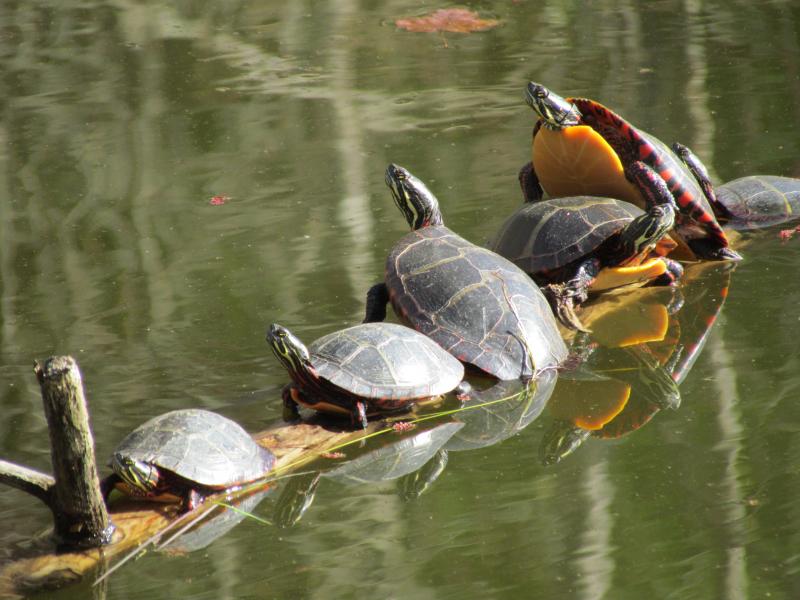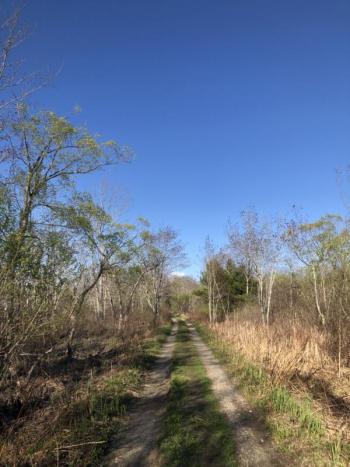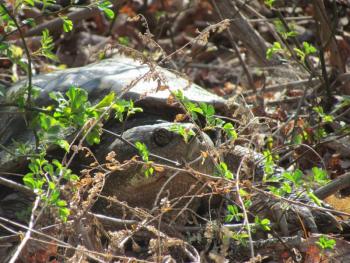After a week of seemingly nonstop Zoom meetings, the weekend arrived, and spring beckoned us outside. We love our home and neighborhood, and we see some amazing birds right here. That includes a very rare white-winged dove just about a week ago, as we wrote in last week’s column. But still, like most people, we like to see new sights and explore other places to see birds and other wild things.
Here in Maine, we are incredibly fortunate that there are public lands that we can explore.
One of our favorite easy spring hikes is at the Green Point Wildlife Management Area in Dresden. A wide gravel road leads from a small parking area along Route 128 and passes through a former orchard. As we started down the path on Sunday evening, bald eagles, osprey, and turkey vultures floated overhead in the brilliant blue sky. We dropped down from the upper orchard into a gulley with a small stream flowing under the road. Birds were not particularly active here this day but we enjoyed watching several frogs floating in the water, safely assuming that we were no threat to them.
A little farther on is the lower orchard. Unlike the upper orchard, which has been cleared of its underbrush, the lower brush has been left to grow wild. This means that it is generally a much better spot for birds. We could hear white-throated sparrows and cardinals singing from within its wonderful, tangled thickets. Another passing birder had mentioned finding a gray catbird earlier. We glanced over at the pond nearby and there on a log were a bevy of painted turtles trying to take in as much of the warm spring sun as possible. The bright yellows of their plastrons (the flat bottom of their shell) seemed to gleam in gorgeous contrast with their shiny dark upper shells and red and yellow marked faces.
Suddenly, about 10 feet away, we heard a rustle in the brush. An enormous prehistoric-looking turtle of another kind—a snapping turtle—was on her way to lay her eggs in a safe, sandy place. We gave her some space so she could continue on with her journey, and we continued with our.
The gravel road straightened out from here, presenting views of the mouth of the Eastern River where it empties into the Kennebec River and Merrymeeting Bay. Twenty common mergansers flew upriver, the males’ black heads outstretched in front of their gleaming white bodies, and the females, with their more subtle, earthy toned brown heads and gray bodies. On one side of the road, the incoming tide pushed muddy brown water into the narrow creek. On the water’s surface, hundreds of tiny fish streamed in a living column, following the current. In the distance a belted kingfisher rattled. Was it after these same fish for its evening meal, we wondered?
The old road took us straight to the Kennebec River, wide and deep here with a view across to Swan Island, another important piece of public land here in the region and one which we have yet to visit and explore ourselves. From here, the road’s sharp 90-degree southward turn brought us out onto the pine-covered point for which Green Point is named. Pine warblers trilled from the massive pine tree that towered above us as we sat on the stone benches that provided a memorial to two well-loved Maine game wardens. A friend that visited the same spot the next day reported seeing a small flock of red crossbills feeding here as well.
Sometimes when we are enjoying these natural places that sustain us with the wonder and beauty and life-affirming experience of nature, we forget that such places are only here because of public support that provides the funding to make these places public lands in the first place. That’s why it is more important than ever that all of us get behind supporting opportunities like the Land for Maine’s Future Bond Act (https://www.nrcm.org/programs/forests-wildlife/land-for-maines-future-program/).
We are already looking forward to returning to Green Point in the near future, when the apple blossoms are in bloom and inviting warblers and grossbeaks and orioles. No doubt we’ll be inspired to write about it here—keep an eye out!
Jeffrey V. Wells, Ph.D., is a Fellow of the Cornell Lab of Ornithology and Vice President of Boreal Conservation for National Audubon. Dr. Wells is one of the nation's leading bird experts and conservation biologists and author of the “Birder’s Conservation Handbook.” His grandfather, the late John Chase, was a columnist for the Boothbay Register for many years. Allison Childs Wells, formerly of the Cornell Lab of Ornithology, is a senior director at the Natural Resources Council of Maine, a nonprofit membership organization working statewide to protect the nature of Maine. Both are widely published natural history writers and are the authors of the popular books, “Maine’s Favorite Birds” (Tilbury House) and “Birds of Aruba, Bonaire, and Curaçao: A Site and Field Guide,” (Cornell University Press).

























